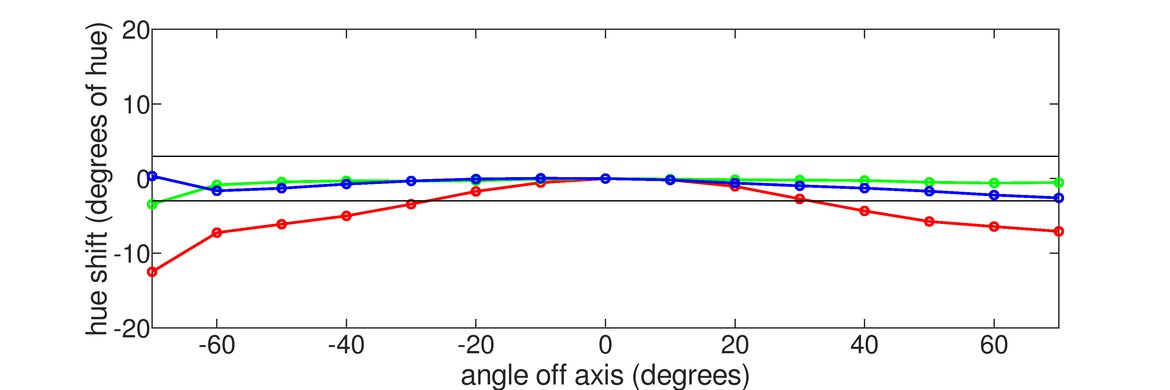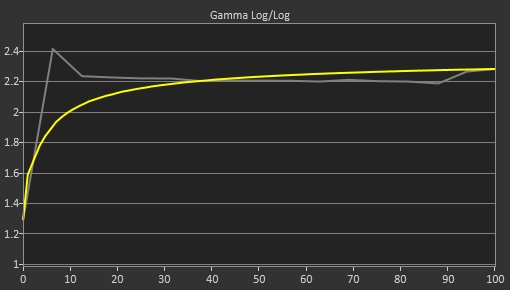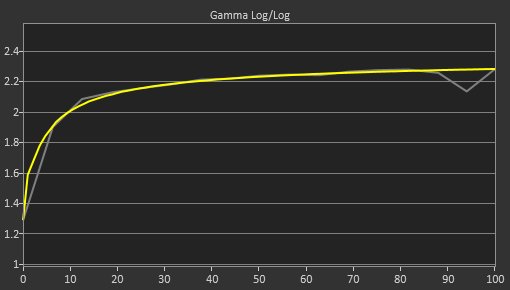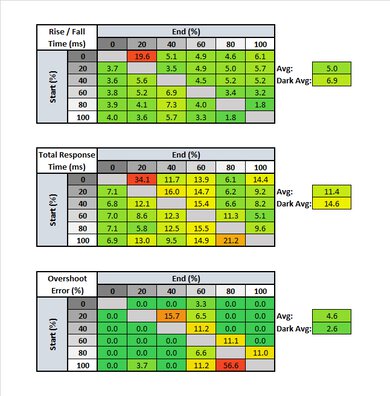Our Verdict
The ASUS TUF Gaming VG32VQ is a good monitor for most uses. It has outstanding low input lag for gaming, and an excellent resolution and size for multitasking or media creation. Unfortunately, the image degrades at an angle, and it has terrible black uniformity.
- Deep blacks.
- Excellent response time.
- Image loses accuracy at an angle.
- Noticeable backlight strobing at low refresh rates.
Decent monitor for office use. It has an excellent amount of screen real estate, great for multitasking, and it has good reflection handling and great peak brightness, so glare shouldn't be an issue in a bright room. Unfortunately, the image degrades when viewed at an angle and the stand has limited ergonomics.
The ASUS TUF VG32VQ is a great monitor for gaming. It has outstanding low input lag, an excellent resolution and size, and an excellent response time. It has an optional black frame insertion feature, which even works with FreeSync enabled, but at low frame rates there is noticeable strobing, which can be distracting.
Decent monitor for multimedia. It has an excellent resolution and size, outstanding low input lag, and good reflection handling. Unfortunately, the image degrades when viewed at an angle, so it isn't a good choice for sharing the screen with someone.
This is a good monitor for media creation. It has an excellent resolution and size, so you can see more of your work at once. It also has outstanding low input lag, and the stand has decent ergonomics. Unfortunately, the image degrades at an angle, so it isn't great for sharing your screen with clients.
Decent monitor for HDR gaming, mainly due to its great gaming performance. It has a good contrast ratio, but only decent HDR peak brightness, so small highlights don't stand out the way they should. Unfortunately, it has terrible black uniformity and no local dimming.
Changelog
- Updated Jan 05, 2022: Updated the Text Clarity score.
- Updated May 11, 2020: Converted to Test Bench 1.1.
- Updated Oct 03, 2019: Review published.
- Updated Oct 01, 2019: Early access published.
Check Price
Differences Between Sizes And Variants
We tested the 32" ASUS TUF VG32VQ, which is the only size available for this model. There are other TUF Gaming models available, some of which are listed below. We do not expect our review to be valid for the other models.
If someone comes across a different type of panel or if their VG32VQ doesn't correspond to our review, let us know and we will update the review. Note that some tests such as gray uniformity may vary between individual units.
| Model | Size | Resolution | Refresh Rate |
| TUF VG32VQ | 32" | 1440p | 144Hz |
| TUF VG27AQ | 27" | 1440p | 165Hz |
| TUF VG27BQ | 27" | 1440p | 165Hz |
| TUF VG35VQ | 35" | 3440x1440p | 100Hz |
| STRIX XG32VQR | 32" | 1440p | 144Hz |
The TUF VG32VQ we reviewed was manufactured in June 2019.
Popular Monitor Comparisons
The ASUS TUF VG32VQ is a great gaming monitor, and it performs similarly to the other 32", 1440p VA monitors we've tested. See also our recommendations for the best gaming monitors and the best 1440p gaming monitors.
The ASUS TUF VG27AQ is significantly better than the ASUS TUF VG32VQ. Though they share the same design, the VG27AQ has an IPS panel with much better viewing angles, color accuracy, and black uniformity. On the other hand, the VG32VQ's VA panel has a better contrast ratio, can get brighter for bright room viewing, though its motion handling isn't as good.
The ASUS TUF VG32VQ is marginally better than the Gigabyte G32QC. The ASUS has better ergonomics, better reflection handling, and faster response time. On the other hand, the Gigabyte has a higher refresh rate, better SDR color gamut, and better color accuracy out-of-the-box.
The ASUS ROG Swift PG348Q and the ASUS TUF VG32VQ use different panel technologies, each with strengths and weaknesses. The PG348Q has much better viewing angles, and the wide aspect ratio is slightly better for multitasking. The VG32VQ supports HDR, and it looks much better in a dark room. The VG32VQ has more advanced gaming features, including a faster refresh rate and an optional black frame insertion feature.
The ASUS TUF VG32VQ is a bit better than the LG 32GK650F-B. The VG32VQ supports HDR and has much better gradient handling, with significantly less banding in areas of similar color. The LG, on the other hand, has better black uniformity, so it's a slightly better choice for users in a dark room.

We buy and test more than 30 monitors each year, with units that we buy completely on our own, without any cherry-picked units or samples. We put a lot into each unbiased, straight-to-the-point review, and there's a whole process from purchasing to publishing, involving multiple teams and people. We do more than just use the monitor for a week; we use specialized and custom tools to measure various aspects with objective data-based results. We also consider multiple factors before making any recommendations, including the monitor's cost, its performance against the competition, and whether or not it's easy to find.
Test Results

The stand is very similar to other ASUS monitors we've tested, including the ASUS ROG Swift PG279QZ. It supports the monitor well, and there is very little wobble.
The back has the same design as most ASUS gaming monitors. There is no RGB bias-lighting feature and no quick-release on the stand. There is a hole in the stand for cable management.
Due to the curvature of the screen, the VG32VQ is thicker than most similarly-sized displays, even when removed from the stand. Like many ASUS monitors, the stand leans back at a small angle, so the overall thickness varies a bit depending on the height of the screen. The above measurements were taken with the monitor placed at the bottom.
The ASUS TUF VG32VQ has great build quality. It feels well-built, very similar to the ASUS ROG Swift PG279Q.
The ASUS TUF VG32VQ has a good contrast ratio. This results in deep blacks and is especially noticeable in a dark room. This is slightly better than the LG 32GK850G and much better than 32" IPS monitors like the LG 32UL950-W.
The ASUS VG32VQ doesn't have a local dimming feature. The above video is provided for reference only.
Great SDR peak brightness; this monitor can easily overcome glare in most rooms. There is no noticeable variation in brightness with different content, which is great.
Decent HDR peak brightness, but small highlights in most HDR content don't stand out as much as they should. There is some variation in peak brightness, especially when displaying large, bright screens, but this shouldn't be noticeable.
Unfortunately, like most VA monitors the image degrades when viewed at an angle. This isn't ideal if you like to share your screen with other people.
Unfortunately, the image degrades considerably when viewed from above or below. This isn't an issue for most people, but if you're planning on mounting the display above you, this could be an issue.
Update 05/15/2020: A previous version stated that the best Trace Free setting was '100', but it's actually '80'.
Out of the box, the TUF VG32VQ has poor accuracy. There are noticeable inaccuracies in many colors and most shades of gray. The color temperature is very cool, resulting in a slightly blueish tint. Gamma is close to the sRGB target curve for the most part, but some dark scenes are over-darkened considerably.
Update 05/15/2020: A previous version stated that the best Trace Free setting was '100', but it's actually '80'.
After calibration, this monitor has much better accuracy. There are still some minor inaccuracies in some colors, but most people won't notice any issues.
You can download our ICC profile calibration here. This is provided for reference only and should not be used, as the calibration values vary per individual unit even for the same model due to manufacturing tolerances.
s.RGB Picture Mode: MOBA (calibrated)
Adobe RGB Picture Mode: MOBA
The TUF VG32VQ has a great SDR color gamut, covering most of the common sRGB color space. Coverage of the wider Adobe RGB color space is too low for most professional photo editing, though.
If you want a monitor with wider coverage of the sRGB color space, take a look at the Gigabyte G32QC.
s.RGB Picture Mode: MOBA
Adobe RGB Picture Mode: MOBA
Excellent SDR color gamut. Thanks to the good contrast ratio, it can display dim saturated colors well. Like most LED displays, it can't display very bright blues, but this shouldn't be very noticeable.
DCI P3 Picture Mode: HDR Gaming
Rec. 2020 Picture Mode: HDR Gaming
Unfortunately, this monitor has mediocre HDR color volume. It can't display the entire color gamut, and some colors aren't as bright as pure white.
There are no signs of temporary image retention on our ASUS TUF Gaming VG32VQ. This varies between units, though, so let us know if your unit performs worse than ours.
Update 01/05/2022: We updated the text clarity score after comparing it to other 32 inch, 1440p monitors. We lowered the score from 8 to 6.5 because there's sub-pixel fringing that you can see around text, typical of some VA panel monitors. The text clarity is okay, but if you care about text clarity, go for a smaller monitor or one with a higher resolution.
Trace Free 0
Trace Free 20
Trace Free 40
Trace Free 60
Trace Free 80
Trace Free 100
This monitor has a great response time, resulting in relatively clear motion, with little blur behind fast-moving objects. The level of overdrive can be customized by adjusting the Trace Free setting. There is very little difference between the settings, and we found that the maximum setting of '80' works best, as it offers the fastest response time with little noticeable overshoot.
When the VG32VQ's BFI setting, 'ELMB SYNC' is enabled, it isn't possible to adjust the response time.
The ASUS TUF Gaming VG32VQ has a flicker-free backlight, which is great. It also has an optional black frame insertion feature, and unlike almost every monitor our there, this feature is available at the same time as FreeSync. The setting that controls this feature is known as 'ELMB SYNC'.
The ASUS TUF VG32VQ has a great 144Hz refresh rate and it supports AMD's FreeSync variable refresh rate technology, for a nearly tear-free gaming experience.
Unfortunately, when low framerate compensation (LFC) kicks in at 48Hz, there is noticeable backlight strobing. As the frame rate decreases, the strobing increases approximately every 10 fps. By the time it reaches 20 fps, the strobing is very distracting. Note that this strobing is noticeable even with the black frame insertion feature disabled.
Over HDMI, VRR only works up to 85Hz at 1440p, but works up to 144Hz if the resolution is decreased to 1080p.
The ASUS TUF VG32VQ has outstanding low input lag in any supported mode. The 60Hz input lag is a bit higher, but still low enough for most casual gamers, and a bit better than the best TVs.
If input lag is important to you and you want the best gaming experience possible, check out our recommendations for the best gaming mice.
The 32", 1440p display delivers an excellent amount of screen real estate, making it a great choice for multitasking. This also makes it easier to see more fine details in your favorite games.
The ASUS TUF VG32VQ has a few additional gaming features. It can add numerous virtual overlays to the display, including crosshairs, an FPS counter, and a timer.




















































